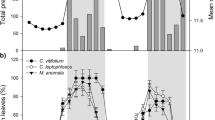Summary
The types and quantities of defense compounds found in plants occupying ecologically distinct habitats have received much theoretical and little empirical attention. Here we characterize the leaf phenolic chemistry of eight species in two genera of tropical rainforest shrubs; four species in each genus are typical of disturbed sites, and four are typical of mature forest understory. Two Miconia species growing in light gaps had significantly higher leaf tannin and total phenolic contents than congenors growing in the primary forest; this pattern was not found among the gap- and forest-adapted Piper species. Tannin patterns were not mirrored by leaf cinnamic acids. These results indicate that plant phylogeny must be considered when predicting plant defense investment.
Similar content being viewed by others
References
Bate-Smith EC (1975) Phytochemistry of proanthocyanidins. Phytochemistry 14:1107–1113
Bate-Smith EC (1977) Astringent tannins of Acer species. Phytochemistry 16:1421–1426
Bazzaz FA, Chiariello NR, Coley PD, Pitelka CF (1987) Allocating resources to reproduction and defense. BioScience 37:58–67
Broadhurst RB, Jones WT (1978) Analysis of condensed tannins using acidified vanillin. J Sci Food Agric 29:788–794
Bryant JP, Chapin FS III, Klein D (1983) Carbon/nutrient balance of forest plants in relation to vertebrate herbivory. Oikos 40:357–368
Butler LG, Price ML, Brotherton JE (1982) Vanillin assay for proanthocyanidins (condensed tannins): Modification of the solvent for estimation of the degree of polymerization. J Agric Food Chem 30:1087–1089
Coley PD (1983) Herbivory and defensive characteristics of tree species in a lowland tropical forest. Ecol Monographs 53:209–233
Coley PD, Bryant JP, Chapin FS III (1985) Resource availability and antiherbivore defense. Science 230:895–899
Denslow JS (1980) Gap partitioning among tropical rainforest trees. Biotropica 12 (Suppl):47–55
Denslow JS, Vitousek PM, Schultz JC (1987) Bioassays of nutrient limitation in a tropical rain forest soil. Oecologia (Berlin) (in press)
Ehrlich PR, Raven PH (1964) Butterflies and plants: A study in coevolution. Evolution 18:586–608
Feeny PP (1976) Plant apparency and chemical defense. Recent Adv Phytochem 10:1–40
Hagerman AE, Nicholson RL (1982) High-performance liquid chromatographic determination of hydroxy cinnamic acids in the maize mesocotyl. J Agric Food Chem 30:1098–1102
Harborne JB (1973) Phytochemical methods, Chapman and Hall, New York, p 78
Hartshorn GS (1978) Treefalls and tropical forest dynamics. In: Tomlinson PB, Zimmerman MH (eds) Tropical trees as living systems. Cambridge Univ Press, Cambridge, UK
Haslam E (1966) Chemistry of vegetable tannins. Academic Press, London
Horvat RJ, Senter SD (1980) A gas-liquid chromatographic method for analysis of phenolic acids in plants. J Agric Food Chem 28:1292–1295
Keller F, Klohs MW (1963) A review of the chemistry and pharmacology of the constitutents of Piper methysticum. Lloydia 26:1015
McKey D (1974) Adaptive patterns in alkaloid physiology. Am Nat 108:305–320
McKey D (1979) The distribution of secondary compounds within plants. In: Rosenthal GA, Janzen DH (eds) Herbivores: Their interaction with secondary plant metabolites. Academic Press, NY, pp 55–135
Newberry DM, Foresta de H (1985) Herbivory and defense in pioneer gap and understory trees in tropical rain forest in French Guiana. Biotropica 17:238–244
O'Hara MJ, Kinnard WJ, Buckley JP (1965) Preliminary characterization of aqueous extracts of Piper methysticum (Kava, Kawa Kawa). J Pharm Sci 54:1021–1025
Richard HM, Jennings WG (1971) Volatile composition of black pepper. J Food Sci 36:584–589
Richards PW (1952) The tropical rainforest. Cambridge Univ Press, Cambridge, UK
Schultz JC, Baldwin IT (1982) Oak leaf quality declines in response to defoliation by gypsy moth larvae. Science 217:149–151
Schultz JC, Baldwin IT, Nothnagle PJ (1981) Hemoglobin as a binding substrate in the quantitative analysis of plant tannins. J Agric Food Chem 29:823–826
Sokal RR, Rohlf FJ (1981) Biometry, 2nd ed. Freeman, San Francisco, CA, USA
Swain T, Hillis WE (1959) The phenolic constituents of Prunus domestica. I. The quantitative analysis of phenolic constituents. J Sci Food Agric 10:63–68
Vitousek PM, Denslow JS (1986) Nitrogen and phosphorus availability on treefall gaps of a lowland tropical forest. J Ecol 74:1167–1178
Author information
Authors and Affiliations
Rights and permissions
About this article
Cite this article
Baldwin, I.T., Schultz, J.C. Phylogeny and the patterns of leaf phenolics in gap-and forest-adapted Piper and Miconia understory shrubs. Oecologia 75, 105–109 (1988). https://doi.org/10.1007/BF00378821
Received:
Issue Date:
DOI: https://doi.org/10.1007/BF00378821




